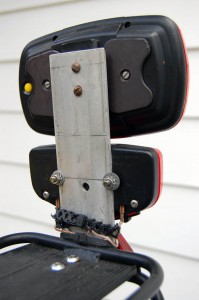| 01/14/12 #239 |
There's a Phoenix bicyclist that I enjoy reading at http://onespeedgo.blogspot.com/, he seems a well-composed and thoughtful person, and when I saw a recent post headline I became quite excited: Rear Rack Taillight Standardized Mounting Dreams Made Real.
Could it be true? Have the stars aligned? Is it a foreshadowing of the Mayan end times? Mounting bicycle tail lights on a rear rack has been a vexing issue for me.
 Unfortunately, the blog post did not bring news of an emerging industry standard. No, we did not adopt the Euro rear light/reflector mounting standard. The writer had taken tools in hand and fabricated his own (and fairly elegant) kludge, and (rightfully) he considered it an accomplishment.
Unfortunately, the blog post did not bring news of an emerging industry standard. No, we did not adopt the Euro rear light/reflector mounting standard. The writer had taken tools in hand and fabricated his own (and fairly elegant) kludge, and (rightfully) he considered it an accomplishment.Generally, we end up with people with really nice bikes who hand-fashion one-off solutions, which often involve fashioning a support that appears to be a seat tube, since all the lights provide mounts for seat tubes:

It's crazy to me that you can spend $50 and up on a rear light that will not reliably affix to your rear rack. Yes, you might zip-tie it and you might clip it onto a bag strap or a coat or a messenger bag, but then the now-remarkable optics will be askew and you'll end up projecting a powerful beam of light up into the air and not into the eyes of the truck behind you.
I really want Them to fix This. I'd like to have one or two templates for what the mounting points on the back of a rear rack might be, and then have higher-end lights be compatible with those templates. I think it might help me to avoid being killed, or at least to maximize the Guilt upon the Driver who does kill me.
This morning I contemplated the great buggery of it all, and then it struck me: I've seen this problem before. When 8086-PCs first came out, none of the devices/software could work together; you needed drivers to intermediate the process. It was a goat-rope; your WordPerfect 4.2 might not have a driver for your HP DeskJet+ if you were still running DOS-5. Every software producer was chasing the swirling range of hardware, and every hardware producer was flummoxed by the upgrading versions of software, and it didn't work very well. It was very frustrating.
Then we got Windows 3.1. Not only was it a graphic user interface, but it provided a standard platform; if your hardware worked with the Windows 3.1 specification, and if your software worked with Windows 3.1, then you could be assured of functionality (UGMT- usually, generally, most of the time).
The hardware people and the software people now only had to worry about a single dimension of change; what would Windows change? And there was really a great improvement delivered by the all-promising Windows.
As happens, after ten years the solution becomes the new problem 2.0, and we've forgotten how glad we were to have Windows 3.1 back in the day.
Somehow, I find myself wishing for Windows 3.1 for my rear bike light / rear rack interface. It's a curious turn of events.
Since I'm fantasizing, I also want to see a standard for a bicycle electric supply. Bicyclists are carrying AA, AAA, recharger packs for proprietary batteries, USB dongles (both mini-USB and USB-2, btw), hearing aid batteries for the new LEDs, and none of them work with each other. I've got
I'd really appreciate a standard platform that allows me to operate all my lights, either on batteries or on a dynamo circuit. I would pay a premium for an electric/light platform that offers some robust diversity in power sources - yes, you can run your dynamo, and if the dynamo craps out you can use your rechargeable AAs or your solar panel- and all your lights would have compatible connectors. I would really like this.
And if you were using rechargables, they should all accept the same mini-USB jack as cellphones do; every traveling cyclist is already carrying a cellphone charger.
Please.
| 1/14/12 Week 2 this week: 78 miles |  | 1st Qtr 143 miles 10.2 mi/dayQTR | 2012: 143 miles | |||
| Weight: Mon:241 Sat:239 Trend: good |
After the recent light hacking experience, I decided that the next taillights I purchase will be from the Planet Bike Superflash or Portland Design Works lines, which have adapters one can purchase to screw onto the standard rack mount, since both my currently installed racks have that, and then try to figure out how to make the blasted clip mounts more permanent. Not only to leave them attached at the bike rack so I don't forget them, but also because I've lost at least two of those clipped on taillights on a modestly bouncy path.
ReplyDeleteI think the hurdle to a standardized voltage / electrical system is that some manufacturer would have to produce a bike with it, and bring it to market at a competitive price against other bikes that don't have the system, and with the expectation that it might not be adapted, meaning the R&D investment might be a loss. I am sort of glad there's not a Microsoft of bicycles, but I guess that also means that making part A interface with part B will continue to require a drill, zip ties, patience, and sloppy mechanical tolerances. But I also hold onto the thought of an easily used standard electrical system. Racks like the Topeak Explorer list "taillight mount" so at least they're trying. But I wonder what taillights they have in mind to mount...
I'm enamored of the PDW Radbot 1000. Thanks for the note!
ReplyDelete